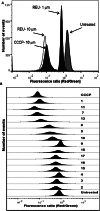Chemical modulation of the biological activity of reutericyclin: a membrane-active antibiotic from Lactobacillus reuteri
- PMID: 24739957
- PMCID: PMC4894453
- DOI: 10.1038/srep04721
Chemical modulation of the biological activity of reutericyclin: a membrane-active antibiotic from Lactobacillus reuteri
Abstract
Whilst the development of membrane-active antibiotics is now an attractive therapeutic concept, progress in this area is disadvantaged by poor knowledge of the structure-activity relationship (SAR) required for optimizing molecules to selectively target bacteria. This prompted us to explore the SAR of the Lactobacillus reuteri membrane-active antibiotic reutericyclin, modifying three key positions about its tetramic acid core. The SAR revealed that lipophilic analogs were generally more active against Gram-positive pathogens, but introduction of polar and charged substituents diminished their activity. This was confirmed by cytometric assays showing that inactive compounds failed to dissipate the membrane potential. Radiolabeled substrate assays indicated that dissipation of the membrane potential by active reutericyclins correlated with inhibition of macromolecular synthesis in cells. However, compounds with good antibacterial activities also showed cytotoxicity against Vero cells and hemolytic activity. Although this study highlights the challenge of optimizing membrane-active antibiotics, it shows that by increasing antibacterial potency the selectivity index could be widened, allowing use of lower non-cytotoxic doses.
Figures



Similar articles
-
Reutericyclin: biological activity, mode of action, and potential applications.Appl Microbiol Biotechnol. 2004 Apr;64(3):326-32. doi: 10.1007/s00253-003-1536-8. Epub 2004 Jan 21. Appl Microbiol Biotechnol. 2004. PMID: 14735324 Review.
-
Characterization of reutericyclin produced by Lactobacillus reuteri LTH2584.Appl Environ Microbiol. 2000 Oct;66(10):4325-33. doi: 10.1128/AEM.66.10.4325-4333.2000. Appl Environ Microbiol. 2000. PMID: 11010877 Free PMC article.
-
Genetic determinants of reutericyclin biosynthesis in Lactobacillus reuteri.Appl Environ Microbiol. 2015 Mar;81(6):2032-41. doi: 10.1128/AEM.03691-14. Epub 2015 Jan 9. Appl Environ Microbiol. 2015. PMID: 25576609 Free PMC article.
-
Equisetin, reutericyclin and streptolodygin as natural product lead structures for novel antibiotic libraries.Future Med Chem. 2015;7(14):1861-77. doi: 10.4155/fmc.15.97. Epub 2015 Oct 2. Future Med Chem. 2015. PMID: 26431450
-
Antibacterial activities of flavonoids: structure-activity relationship and mechanism.Curr Med Chem. 2015;22(1):132-49. doi: 10.2174/0929867321666140916113443. Curr Med Chem. 2015. PMID: 25245513 Review.
Cited by
-
Structural Studies of β-Diketones and Their Implications on Biological Effects.Pharmaceuticals (Basel). 2021 Nov 20;14(11):1189. doi: 10.3390/ph14111189. Pharmaceuticals (Basel). 2021. PMID: 34832971 Free PMC article. Review.
-
Synthesis and Biological Evaluation of the Antimicrobial Natural Product Lipoxazolidinone A.Angew Chem Int Ed Engl. 2018 Jul 9;57(28):8682-8686. doi: 10.1002/anie.201805078. Epub 2018 Jun 10. Angew Chem Int Ed Engl. 2018. PMID: 29845720 Free PMC article.
-
Development of Methionyl-tRNA Synthetase Inhibitors as Antibiotics for Gram-Positive Bacterial Infections.Antimicrob Agents Chemother. 2017 Oct 24;61(11):e00999-17. doi: 10.1128/AAC.00999-17. Print 2017 Nov. Antimicrob Agents Chemother. 2017. PMID: 28848016 Free PMC article.
-
Synthesis, structure-activity relationship studies, and antibacterial evaluation of 4-chromanones and chalcones, as well as olympicin A and derivatives.J Med Chem. 2014 Oct 23;57(20):8398-420. doi: 10.1021/jm500853v. Epub 2014 Oct 7. J Med Chem. 2014. PMID: 25238443 Free PMC article.
-
The biofilm inhibitor Carolacton inhibits planktonic growth of virulent pneumococci via a conserved target.Sci Rep. 2016 Jul 11;6:29677. doi: 10.1038/srep29677. Sci Rep. 2016. PMID: 27404808 Free PMC article.
References
Publication types
MeSH terms
Substances
Grants and funding
LinkOut - more resources
Full Text Sources
Other Literature Sources
Medical
Molecular Biology Databases
Miscellaneous

